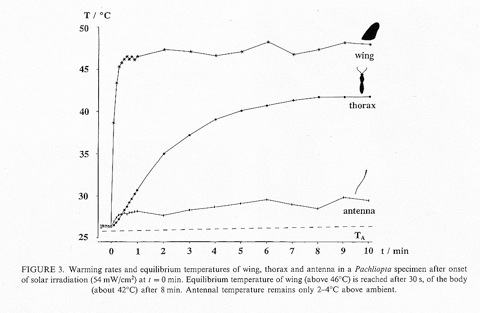Schmitz, H. und Wasserthal, L.T. (1993): Antennal thermoreceptors and wing-thermosensivity of heliotherm butterflies: their possible role in thermoregulatory behaviour. J. Insect Physiol. 39, 1007-1019.
Irradiation experiments in freshly killed black papilionids under natural sunlight and minimized wind convection showed that antennae, wings and thorax heat with different warming rates and reach different specific excess temperatures under moderate radiation. While the “low-mass” antennal clubs retain almost temperature of the ambient air, the well-insulated “medium-mass” basal wing veins attain vulnerable excess temperatures after about 15 s when fully exposed, Tequilibr of antennae is 28°C and of forewing 46°C both after 30 s, Tequilibr of the thorax is 42°C after 8 min, all at Tambient of 26°C and under 54 mW/cm2. The antennal clubs are optimally suitable for measurement of ambient temperature in spite of being fully exposed to the sun. They are equipped with sensilla basiconica. These poreless sensilla with triads of Type I receptors (typical for thermo/hygroreceptors) and their ultrastructure are described for the first time in butterflies. By scanning the wing veins of free-resting Troides with a calibrated light beam of 1 mm in diameter, a slow wing closing reaction could be evoked at discrete sites along most veins, indicating the existence of a sensory system for increasing temperatures. A heating rate of 2.4–4°C/s of the irradiated wing area was necessary to elicit a response. The applied radiation produced an equilibrium temperature of 39 ± 3°C at the basal veins A2 and A3 after about 12 s. With axonal filling (CoCl2) and electron microscopic techniques multiterminal sensory cells (Type II receptors) are traced and described. Some of them are suggested to function as warm receptors. The different role of the peripheral thermoreceptor systems in thermoregulation is discussed.

While the antenna attains only temperature values around ambient T, the wings heat very fast to lethal excess temperatures

